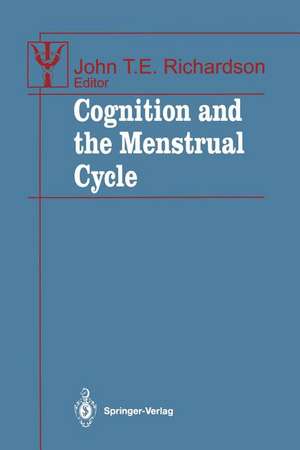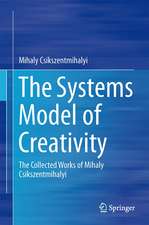Cognition and the Menstrual Cycle: Contributions to Psychology and Medicine
Editat de John T.E. Richardsonen Limba Engleză Paperback – 14 dec 2011
Preț: 384.48 lei
Nou
Puncte Express: 577
Preț estimativ în valută:
73.57€ • 76.97$ • 61.12£
73.57€ • 76.97$ • 61.12£
Carte tipărită la comandă
Livrare economică 03-17 aprilie
Preluare comenzi: 021 569.72.76
Specificații
ISBN-13: 9781461391500
ISBN-10: 1461391504
Pagini: 232
Ilustrații: XI, 216 p.
Dimensiuni: 155 x 235 x 12 mm
Greutate: 0.33 kg
Ediția:Softcover reprint of the original 1st ed. 1992
Editura: Springer
Colecția Springer
Seria Contributions to Psychology and Medicine
Locul publicării:New York, NY, United States
ISBN-10: 1461391504
Pagini: 232
Ilustrații: XI, 216 p.
Dimensiuni: 155 x 235 x 12 mm
Greutate: 0.33 kg
Ediția:Softcover reprint of the original 1st ed. 1992
Editura: Springer
Colecția Springer
Seria Contributions to Psychology and Medicine
Locul publicării:New York, NY, United States
Public țintă
ResearchCuprins
1 The Menstrual Cycle, Cognition, and Paramenstrual Symptomatology.- Menstrual Symptomatology.- Premenstrual Symptomatology.- Oral Contraceptives and Paramenstrual Symptomatology.- The Constituent Structure of Premenstrual Symptomatology.- Cognition and the Menstrual Cycle.- 2 Cognitive Performance and the Menstrual Cycle.- Research Issues.- Definitions and Scope.- Survey of the Literature.- Discussion and Conclusions.- 3 Visual Information Processing and the Menstrual Cycle.- The Menstrual Cycle as a Biological Rhythm.- Visual Sensitivity and the Menstrual Cycle.- Psychophysiological Responsiveness and the Menstrual Cycle.- Arousal and Activation in the Central Nervous System.- Arousal and Activation in the Autonomic Nervous System.- Mood, Symptomatology, and Performance.- Critical Flicker Fusion Threshold and the Menstrual Cycle.- Discussion.- 4 Memory and the Menstrual Cycle.- Hormonally Mediated Effects Upon Cognitive Performance.- Long-Term Memory and the Menstrual Cycle.- Stress-Mediated Effects Upon Cognitive Performance.- Short-Term Memory and the Menstrual Cycle.- General Conclusions.- 5 The Demise of Dissent and the Rise of Cognition in Menstrual-Cycle Research.- Mood and the Menstrual Cycle.- Stress and Menstruation.- Stress as a Trait.- Summary of Two Research Projects.- Hero-Innovator or Rational Reductionist? Strategies of Menstrual-Cycle Research.- Entrenchment and Stagnation: The Inevitable or Escapable?.- Beyond Criticism and Deconstruction: Toward a Reconstructed Theory of the Menstrual Cycle.- 6 Menstrual-Cycle Research and the Construction of Female Psychology.- The Construction of Female Psychology.- The Construction of the Female Body.- Women’s Beliefs.- Reproductive Cycles and Clinical Discourse.- The Clinical Tradition.- Diagnostic Categoriesand the Social Construction of Female Psychology.- Psychological Knowledge and Sexual Politics.- Popular Representations in Everyday Understanding.- Conclusions.- Author Index.



















